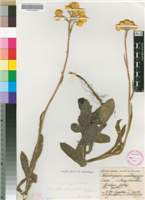Origin of name:
xeros = drychrysos = old, yellow
Diagnostic characters:
Bright yellow bracts with orange-brown tipsLarge flower headsOpen branched inflorescence on long stalks
Description:
Perennial herb, rootstock woody, crowned with one or a few leaf rosettes, flowering stems one or a few lateral to the rosette, erect, simple, leafy below, becoming pedunculoid and distantly bracteate upwards, tawny- or grey-woolly. Radical leaves c. 60�100 x 25�50 mm, oblong-elliptic, apex subacute, base slightly narrowed, clasping, both surfaces grey-woolly; cauline leaves similar but becoming lanceolate upwards, broad-based, decurrent in long narrow wings. Heads homogamous, subglobose, c. 10 x 20 mm across when fully radiating, few on nude peduncles in a lax corymbose panicle. Involucral bracts in c. 10 series, graded, loosely imbricate, inner exceeding flowers, radiating, acute, golden-yellow overlaid reddish brown. Receptacle with fimbrils exceeding ovaries. Flowers 122�240. Achenes not seen, ovaries glabrous. Pappus bristles many, equaling corolla, yellow, barbellate in upper half, bases cohering strongly by patent cilia.
Flowering in December and January.
Distribution:
Grows on moist grassy mountain and hill slopes. Ranges from southernmost KwaZulu-Natal (Alfred and Ixopo districts) through the Transkei to the Amatola Mountains, Katberg, Boschberg at Somerset East, and Grahamstown.
Grassland and Thicket Biomes.
Notes:
Distinctive and easily recognized.
Taxonomy:
Literature:
Helichrysum xerochrysum DC., Prodr. 6: 201 (1838); Harv. in F. C. 3: 243 (1865); Moeser in Bot. Jb. 44: 321 (1910).
Type:
Cape, between the Kei and Bashee, Dr�ge 5020 (G-DC, holo.; BM; P, iso.).
Synonym(s):
Gnaphalium xerochrysum (DC.) Sch. Bip. in Bot. Ztg 3: 171 (1845).
Vouchers:
Acocks 9573 (PRE); Flanagan 2650 (PRE; SAM); Galpin 6296 (PRE); Hilliard & Burtt 11206 (E; K; MO; NU; PRE; S); Pegler 1571 (BM).

